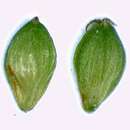Comprehensive Description
provided by North American Flora
Carex hirsutella Mackenzie, Bull. Torrey Club 50: 349. 1923
Carex hirsuta Willd. Sp. PI. 4: 252. 1805. (Type from North America.) Not C. hirsuta Suter,
1802. "Carex viridula Michx." Schw. & Torr. Ann. Lye. N. Y. 1: 320. 1825. Olamblis hirsuta Raf. Good Book 26. 1840. (Based on Carex hirsuta Willd.)
Carex triceps var. hirsuta L. H. Bailey, Mem. Torrey Club 1 : 35. 1889. (Based on C. hirsuta Willd.) "Carex triceps Michx." Britt. & Brown, 111. Fl. 1 : 316. 1896.
"Carex complanata Torr." Mackenzie, in Britt. & Brown, 111. Fl. ed. 2. 1: 414. 1913. Carex complanata var. robusta Burnham, Torreya 19: 134. 1919. (Tvpe from Lake George, New York.)
Cespitose, not stoloniferous, the culms slender but stiff and erect, 2-9 dm. high, growing in small to good-sized clumps, somewhat pubescent, triangular with slightly concave sides, usually exceeded by the upper leaves, strongly reddened at base; well-developed leaves usually 5 or 6 to a culm, on lower fourth (except uppermost) but not bunched at base, not septatenodulose, the blades strongly short-pubescent on both sides, 1-2.5 dm. long, 1.5-4 mm. wide, flat, not thickish and not stiff, erect-ascending, the upper culm-leaf inserted from moderately to much below the inflorescence, but usually exceeding it; sheaths long, tight, hairy, concave and short-pilose at mouth, the ligule wider than long; spikes 2-5, usually 3 or 4, oblong or oblong-cylindric, 6-18 mm. long, 5-7 mm. wide, the uppermost gynaecandrous with lower third staminate and clavate, the others pistillate, all approximate or the lower somewhat separate, erect, sessile or very short-peduncled, closely 15-30-flowered, in several to many rows; lower bract 1.5 mm. wide, about three times the length of the inflorescence, the others much smaller; pistillate scales ovate-triangular, with green 3-nerved center and broad hyaline margins, narrower and shorter than the perigynia, varying from short-cuspidate to obtuse; staminate scales whitish with green midrib, acuminate or cuspidate; perigynia broadly obovoid or obovoid-orbicular, obscurely obtusely triangular, markedly flattened ventrally at maturity, appressed or ascending, submembranaceous, more or less granular, slightly more than 2 mm. long, 1.5 mm. wide, round-tapering at base, rounded and very obtuse at apex, or very minutely pointed, strongly several-nerved dorsally, more lightly several-nerved ventrally; achenes sharply triangular with concave sides and prominent rounded angles, obovoid, nearly filling the perigynium, 1.75 mm. long, 1.25 mm. wide, sessile, short-apiculate with somewhat bent tip, jointed with the very short thickish style; stigmas 3, slender, short; anthers yellowish.
Type locality (of Carex hirsuta Willd. on which C. hirsutella is based): "Habitat in America boreali."
Distribution: Dry copses and meadows, best developed in calcareous districts, Maine to southern Ontario and Michigan, and southward to Alabama and Texas. (Specimens examined from Maine, Vermont, Massachusetts, Connecticut, New York, New Jersey, Pennsylvania, Delaware, Maryland, District of Columbia, Virginia, West Virginia, North Carolina, South Carolina, Alabama, Mississippi, Ontario, Ohio, Michigan, Indiana, Kentucky, Tennessee, Illinois, Iowa, Missouri, Arkansas, Oklahoma, Texas.)
- bibliographic citation
- Kenneth Kent Mackenzie. 1935. (POALES); CYPERACEAE; CARICEAE. North American flora. vol 18(6). New York Botanical Garden, New York, NY

